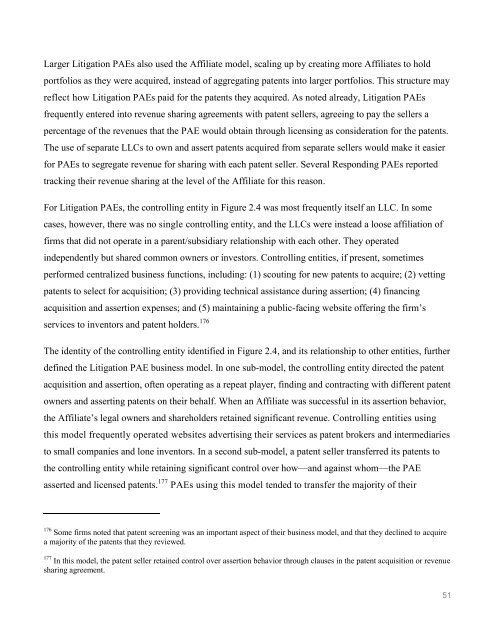You also want an ePaper? Increase the reach of your titles
YUMPU automatically turns print PDFs into web optimized ePapers that Google loves.
Larger Litigation PAEs also used the Affiliate model, scaling up by creating more Affiliates to hold<br />
portfolios as they were acquired, instead of aggregating patents into larger portfolios. This structure may<br />
reflect how Litigation PAEs paid for the patents they acquired. As noted already, Litigation PAEs<br />
frequently entered into revenue sharing agreements with patent sellers, agreeing to pay the sellers a<br />
percentage of the revenues that the PAE would obtain through licensing as consideration for the patents.<br />
The use of separate LLCs to own and assert patents acquired from separate sellers would make it easier<br />
for PAEs to segregate revenue for sharing with each patent seller. Several Responding PAEs reported<br />
tracking their revenue sharing at the level of the Affiliate for this reason.<br />
For Litigation PAEs, the controlling entity in Figure 2.4 was most frequently itself an LLC. In some<br />
cases, however, there was no single controlling entity, and the LLCs were instead a loose affiliation of<br />
firms that did not operate in a parent/subsidiary relationship with each other. They operated<br />
independently but shared common owners or investors. Controlling entities, if present, sometimes<br />
performed centralized business functions, including: (1) scouting for new patents to acquire; (2) vetting<br />
patents to select for acquisition; (3) providing technical assistance during assertion; (4) financing<br />
acquisition and assertion expenses; and (5) maintaining a public-facing website offering the firm’s<br />
services to inventors and patent holders. 176<br />
The identity of the controlling entity identified in Figure 2.4, and its relationship to other entities, further<br />
defined the Litigation PAE business model. In one sub-model, the controlling entity directed the patent<br />
acquisition and assertion, often operating as a repeat player, finding and contracting with different patent<br />
owners and asserting patents on their behalf. When an Affiliate was successful in its assertion behavior,<br />
the Affiliate’s legal owners and shareholders retained significant revenue. Controlling entities using<br />
this model frequently operated websites advertising their services as patent brokers and intermediaries<br />
to small companies and lone inventors. In a second sub-model, a patent seller transferred its patents to<br />
the controlling entity while retaining significant control over how—and against whom—the PAE<br />
asserted and licensed patents. 177 PAEs using this model tended to transfer the majority of their<br />
176<br />
Some firms noted that patent screening was an important aspect of their business model, and that they declined to acquire<br />
a majority of the patents that they reviewed.<br />
177<br />
In this model, the patent seller retained control over assertion behavior through clauses in the patent acquisition or revenue<br />
sharing agreement.<br />
51


